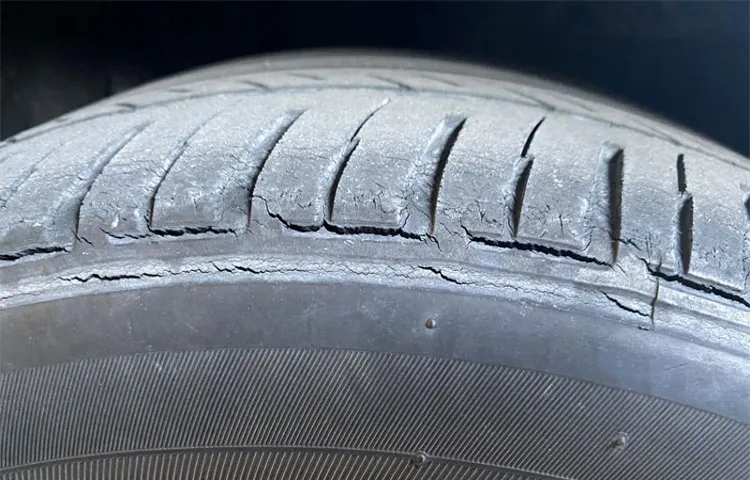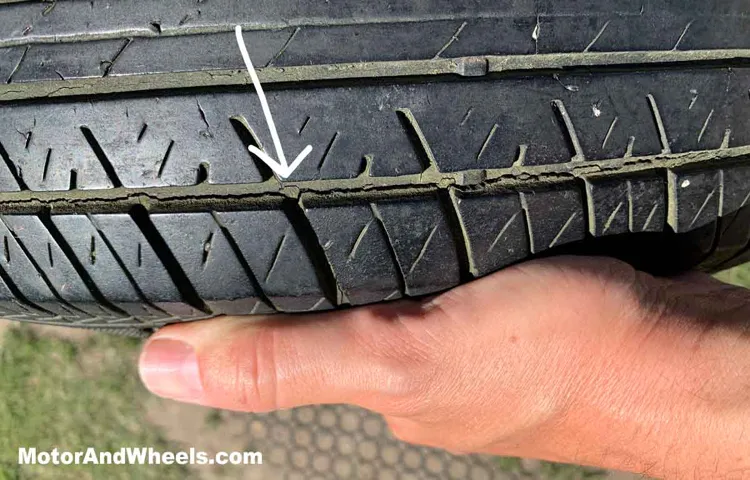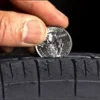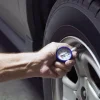Have you ever wondered when it’s time to replace your tires due to cracks in the tread? The answer may surprise you. It all depends on the severity and location of the cracks. Tire tread plays a vital role in maintaining traction on the road, ensuring your safety while driving.
Therefore, it’s important to keep an eye on any signs of wear and tear. As a general rule of thumb, cracks that are less than 2/32 of an inch deep are deemed safe, as they don’t affect the overall performance of the tire. However, deeper and more extensive cracks can weaken the tire’s structure, making it prone to blowouts and accidents.
In this blog post, we’ll dive deep into the world of tire cracks and explore when they become unsafe to drive on.
Table of Contents
Understanding Tire Cracks
When it comes to tire safety, it’s important to look out for cracks in the tread. But not all cracks are created equal. In general, if the cracks are less than 1/16 of an inch deep, they’re likely just surface cracks and don’t pose a significant risk.
However, if the cracks are deeper than that, or if they’re located near the sidewall of the tire, it could be a sign of more serious damage. It’s also important to remember that cracks can vary in severity depending on the ambient temperature and how often the tire is driven. If you’re unsure about the condition of your tire, it’s always best to take it to a professional to have it checked out.
Overall, as long as you keep an eye on the condition of your tires, you should be able to detect any potential issues before they become a safety hazard on the road.
Types of Tire Cracks
Tire cracks are a common problem that many drivers encounter, and it’s essential to understand their types to ensure your safety on the road. There are numerous types of tire cracks such as dry, weathered, sidewall, and tread cracks. Dry cracks are vertical splits on the surface of the tire’s rubber caused by aging and exposure to sunlight.
Weathered cracks, on the other hand, occur due to exposure to harsh weather conditions like snow, rain, and humidity. Sidewall cracks are severe and can result from too much weight on the tires or under-inflation, causing bulges and deformities on the sidewall. Lastly, tread cracks mostly occur due to low tire pressure, leading to uneven wear and tear on the tire’s surface.
It’s crucial to keep a close eye on your tires’ condition and replace them if you notice any cracks to avoid accidents on the road.

Causes of Tire Cracks
Tire cracks can be a major safety concern when it comes to driving your vehicle. There are many possible causes of tire cracks, including age, weather conditions, overinflation or underinflation, and even poor driving habits. Overinflation or underinflation can cause uneven wear on the tire and may also lead to cracks.
Extreme temperatures, especially hot weather, can cause the rubber on the tire to break down and crack. Additionally, long-term exposure to UV radiation from the sun can cause the tire to dry out over time and become brittle, resulting in cracks. It’s essential to regularly check your tire pressure and have your tires inspected by a professional to ensure they are in good condition and free of cracks.
Remember, tire cracks are a serious safety concern, so always stay vigilant and take care of your vehicle’s tires.
The Dangers of Driving with Cracked Tires
It can be tempting to brush off those small cracks in your tire tread as nothing to worry about, but the truth is, driving with cracked tires can be incredibly dangerous. Cracks in the rubber can weaken the tire’s structural integrity, leaving it at risk for a blowout or flat tire. Not to mention, as the cracks deepen and widen, they can trap water and other debris, increasing the risk of hydroplaning.
In general, any crack larger than 2/32 of an inch can be cause for concern and should be inspected by a professional. Don’t put your safety at risk – if you notice cracks in your tire tread, take it seriously and have it checked out before hitting the road.
Increased Risk of Blowouts
Driving with cracked tires can be extremely dangerous, as it significantly increases the risk of blowouts. A blowout occurs when a tire suddenly loses air pressure, causing the tire to burst. This can result in a loss of control of the vehicle and potentially cause a serious accident.
Unusual vibrations and visible cracks on the tire can signal the onset of a blowout. Drivers should immediately replace any worn or damaged tires, as postponing this can be disastrous. It’s also important to regularly inspect your tires, maintain proper tire pressure, and avoid driving on rough terrain to prevent crack formation.
Ignoring the signs of a cracked tire is not worth the risk – always prioritize safety on the road.
Reduced Traction on Wet Roads
Reduced Traction on Wet Roads Due to Cracked Tires Driving in wet and rainy conditions can be dangerous if your vehicle is not equipped with the right set of tires. Rainwater on the road surface reduces the friction between your car’s tires and the road, making it more difficult to control your vehicle’s movement. This is where the condition of your tires becomes crucial.
Cracked tires not only impair your vehicle’s handling and braking but also reduce the tire’s grip on wet roads. When your tires are cracked, they lose their flexibility, and the cracks become an entry point for moisture and water, making the tire surface slippery and reducing the traction on wet roads. As a result, you may experience hydroplaning, which occurs when your tires lose contact with the road surface and float on top of the water layer.
This can cause your car to slide or skid and lose control, leading to accidents and injuries. It’s essential to inspect your tires regularly for any cracks, punctures, or wear and replace them if necessary. Proper inflation and alignment also play a vital role in maintaining the tire’s condition and performance.
Investing in high-quality tires designed for wet conditions and ensuring they are in good condition is critical for your safety and the safety of others on the road. In conclusion, driving on wet and slippery roads requires extra precaution, and having cracked tires only adds to the risk. Don’t let damaged, old, or worn tires put you and your passengers’ safety in jeopardy.
Take care of your tires, and they’ll take care of you on the road.
Negative Impact on Fuel Economy
Driving with cracked tires can negatively impact your vehicle’s fuel economy. When a tire is cracked, it is usually a sign of worn-out tread, which means the tire is not able to grip the road as well as it should. This increases rolling resistance, which in turn affects fuel economy.
Additionally, cracked tires often lead to a decrease in air pressure, which can cause further damage to the tire and the vehicle’s suspension system. In the worst-case scenario, a blown tire can cause an accident, resulting in injury or even death. Regularly checking your tires for cracks and other signs of wear and tear is crucial for maintaining a safe and fuel-efficient vehicle.
If you’re unsure about the condition of your tires, don’t hesitate to take your car to a professional for an inspection. Investing in a new set of tires may be costly, but the long-term benefits in terms of safety and fuel economy are well worth it.
How to Check for Unsafe Cracks in Tires
Cracks in tire treads can be alarming, but not all cracks are unsafe. When checking for unsafe cracks, look for cracks that are deeper than 1/16 of an inch or extend across the entire width of the tire. Tires that have visible cords or fabric are also unsafe and should be replaced immediately.
Age is also a factor – tires that are over six years old are more likely to develop unsafe cracks, even if they have low mileage. It’s important to regularly inspect your tires for any signs of damage and replace them if necessary. Don’t take any chances with your safety on the road!
The Penny Test
The penny test is a quick and easy way to check if your tires are safe to drive on. Simply take a penny and insert it into the grooves of your tire tread with Lincoln’s head facing downwards. If you can see the top of Lincoln’s head, this means your tire tread is worn and it’s time for a replacement.
This test is especially important as it can help determine if there are any unsafe cracks in the tires. Cracks on the sidewall of the tire can be a sign of dry rot, which means that the rubber of the tire has deteriorated and could lead to a blowout while driving. If you notice any signs of cracks or damage, it’s important to get your tires checked by a professional as soon as possible.
Don’t put yourself or others at risk by driving on tires that are worn or damaged. Keep yourself safe on the road with regular tire inspections and replacements when necessary.
Visual Inspection
When inspecting your tires, one crucial aspect is to check for any unsafe cracks that could lead to tire failure. It’s not just about the tread depth or tire pressure; a visual inspection is equally important. Start by examining the sidewalls of the tire, where you’re most likely to see cracks or cuts.
Look for any irregularities or damages that extend deep into the rubber, as this could indicate a structural problem. Don’t confuse normal weathering cracks from unsafe cracks. Normal cracks usually appear as hairline or shallow cracks on the surface of the tire and are just cosmetic.
Unsafe cracks, on the other hand, are deep, long, and extend along the tread pattern and circumference. These cracks can occur due to overloading, underinflation, or age and have a high potential to cause a sudden blowout. If you notice any unsafe cracks, replace the tire right away.
Remember, a properly maintained tire is vital for your safety on the road.
When to Replace Cracked Tires
When it comes to cracked tire treads, safety should always be a top priority. Small cracks in the tire tread are usually normal wear and tear, but when the cracks become large and deep, it’s time to replace them. Cracks in the tread can compromise the tire’s ability to maintain traction on wet or slippery surfaces, making it dangerous to drive in rainy weather.
Additionally, deep cracks can lead to blowouts while driving, which can cause an accident. To determine whether your tire needs to be replaced, check for any cracks or bulges on the tire’s surface. If you see any, it’s best to take the tire to a professional for inspection.
Remember, it’s better to be safe than sorry when it comes to your tires.
Conclusion
In conclusion, much like our own personal lives, tires are susceptible to cracks, wear and tear. While some cracks in tire tread are harmless, others warrant immediate attention and replacement. As a rule of thumb, if the crack is deeper than 1/16th of an inch or is located on the sidewall, it’s time to bid farewell to your beloved tire.
So, keep your eyes peeled for any worrisome cracks and give your tires the love and care they deserve – after all, they’re the only things standing between you and the open road!”
FAQs
How do I know if the cracks in my tire tread are unsafe?
If the cracks are deeper than 2/32 of an inch and extend across the entire tread, the tire is considered unsafe and needs to be replaced.
Can I drive on tires with small cracks in the tread?
It is not recommended to drive on tires with any cracks in the tread, as they can worsen and eventually become unsafe.
What causes cracks to appear in tire tread?
Cracks can appear in tire tread due to age, exposure to UV rays, and excessive use or misuse of the tire.
Can tire tread cracks be repaired?
No, cracks in tire tread cannot be repaired and the tire must be replaced.
How often should I check my tire tread for cracks?
It is recommended to check your tire tread for cracks every time you perform routine tire maintenance or at least once a month.
Are cracks in tire sidewalls also unsafe?
Yes, cracks in tire sidewalls are also considered unsafe and the tire should be replaced.
What is the lifespan of a tire before cracks typically appear in the tread?
Tires can last anywhere from 5-10 years before cracks begin to appear in the tread, depending on usage and maintenance.



